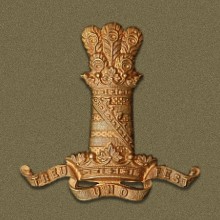
The 11th Hussars (Prince Albert's Own) was a cavalry regiment of the British Army established in 1715. It saw service for three centuries including the First World War and Second World War but then amalgamated with the 10th Royal Hussars (Prince of Wales' Own) to form the Royal Hussars in 1969.
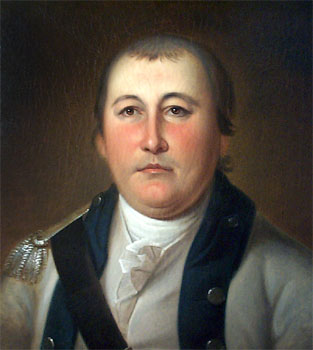
William Washington was a cavalry officer of the Continental Army during the American Revolutionary War, who held a final rank of brigadier general in the newly created United States after the war. Primarily known as a commander of light dragoons, he led mounted troops in a number of notable battles in the Carolinas during the campaigns of 1780 and 1781.

Sir George Nugent, 1st Baronet, GCB was a British Army officer. After serving as a junior officer in the American Revolutionary War, he fought with the Coldstream Guards under the Duke of York during the Flanders Campaign. He then commanded the Buckinghamshire Volunteers in the actions of St. Andria and Thuyl on the river Waal and participated in the disastrous retreat from the Rhine. He went on to be commander of the northern district of Ireland, in which post he played an important part in placating the people of Belfast during the Irish Rebellion, and then became Adjutant-General in Ireland. He went on to be Governor of Jamaica, commander of the Western District in England, commander of the Kent District in England and finally Commander-in-Chief, India.

The 50th Regiment of Foot was an infantry regiment of the British Army, raised in 1755. Under the Childers Reforms it amalgamated with the 97th Regiment of Foot to form the Queen's Own Royal West Kent Regiment in 1881.

The 13th Hussars was a cavalry regiment of the British Army established in 1715. It saw service for three centuries including the Napoleonic Wars, the Crimean War and the First World War but then amalgamated with the 18th Royal Hussars, to form the 13th/18th Royal Hussars in 1922.
Lieutenant-General Thomas Mahon, 2nd Baron Hartland, styled Hon. Thomas Mahon from 1800 to 1819, was an Irish soldier, politician and peer. Son of a landed proprietor with an estate at Strokestown, he joined the British Army, serving for most of his career with the 9th Light Dragoons. His garrison skillfully ambushed and destroyed a force of United Irishmen at the Battle of Carlow in 1798. He briefly represented County Roscommon in the Irish and UK Parliaments as part of his father's successful scheme to obtain a peerage by supporting the Union, but this was not popular with the county electors, and he abandoned Parliament in 1802 to return to the military. He had the misfortune to be present at two military debacles of the Napoleonic Wars, the second invasion of the Río de la Plata and the Walcheren Campaign, and while he was not personally implicated in either, he saw no further notable military service. Mahon succeeded his father as Lord Hartland in 1819 and died without issue in 1835, his title and estates passing to his youngest brother.
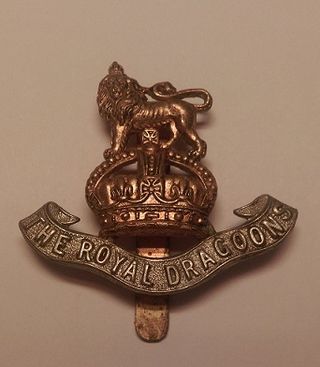
The Royal Dragoons was a heavy cavalry regiment of the British Army. The regiment was formed in 1661 as the Tangier Horse. It served for three centuries and was in action during the First and the Second World Wars. It was amalgamated with the Royal Horse Guards to form The Blues and Royals in 1969.
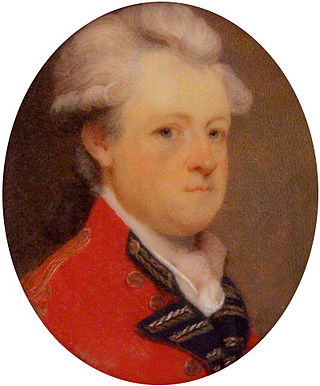
Field Marshal William Harcourt, 3rd Earl Harcourt, was a British nobleman and British Army officer. He served as an aide-de-camp to Lord Albemarle for the expedition to Havana during the Seven Years' War. He also commanded his regiment at the Battle of White Plains and then captured General Charles Lee at Basking Ridge during the American Revolutionary War. After that he commanded the British Cavalry at the Battle of Willems during the Flanders Campaign. He succeeded the Duke of York as commander during that campaign and oversaw the British retreat and their final evacuation from Bremen. His last main military role was as Governor of the Royal Military College at Great Marlow.

The 14th King's Hussars was a cavalry regiment in the British Army, first raised in 1715. It saw service for two centuries, including the First World War, before being amalgamated with the 20th Hussars to form the 14th/20th King's Hussars in 1922.

The 39th (Dorsetshire) Regiment of Foot was an infantry regiment of the British Army, raised in 1702. Under the Childers Reforms it amalgamated with the 54th Regiment of Foot to form the Dorsetshire Regiment in 1881.

The 7th Dragoon Guards was a cavalry regiment in the British Army, first raised in 1688 as Lord Cavendish's Regiment of Horse. It was renamed as the 7th Dragoon Guards for Princess Charlotte in 1788. It saw service for two centuries, including the First World War, before being amalgamated with the 4th Royal Irish Dragoon Guards, to form the 4th/7th Dragoon Guards in 1922.
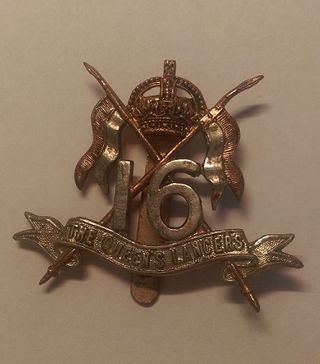
The 16th The Queen's Lancers was a cavalry regiment of the British Army, first raised in 1759. It saw service for two centuries, before being amalgamated with the 5th Royal Irish Lancers to form the 16th/5th Lancers in 1922.

The 15th The King's Hussars was a cavalry regiment in the British Army. First raised in 1759, it saw service over two centuries, including the First World War, before being amalgamated with the 19th Royal Hussars into the 15th/19th The King's Royal Hussars in 1922.

General Sir Loftus William Otway, CB was an experienced and professional cavalry commander of British forces during the Peninsula War who saw extensive service under Sir John Moore in the Corunna Campaign and Wellington in the remainder of the campaign. He also worked training Portuguese troops and spent time serving in Ireland during the 1798 rebellion and Canada. Otway retired after the Peninsula War and was honoured several times for his war service by both the British and Spanish royal families.
General Sir James Steuart Denham, 8th and 4th Baronet was a Scottish soldier of the British Army.
General Flower Mocher, was a British army officer who served 50 years in the cavalry. He initially obtained a commission with Hawley's Dragoons then, following 12 years service with the Horse Grenadier Guards, he served 17 years with the Dragoon Guards as their Lieutenant Colonel and Colonel. Two years before his appointment as a general officer he was made Colonel of the 9th Regiment of Dragoons in Ireland. After some years service as deputy to the commander-in-chief Ireland he retired in 1794 shortly before his appointment to the rank of full General.

General William Loftus was a British Army officer and Member of Parliament.

General Sir William Keir Grant, KCB, GCH was a British Army general during the first half of the 19th century.
Major-General Lord Frederick Cavendish-Bentinck known as Lord Frederick Bentinck was a British soldier and politician.
The Windsor Foresters, or more formally the Berkshire Fencible Cavalry, was a British regiment of cavalry raised for home defence in 1794. It served in Lincolnshire and Scotland on coastal defence and anti-smuggling duties until 1800. A second regiment, the Berkshire Provisional Cavalry was converted into fencible cavalry in 1799. Both regiments were disbanded in 1800, when a number of members transferred to a new Yeomanry Cavalry Troop at Wargrave.















